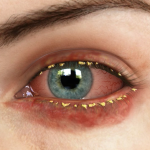The Argus® II Retinal Prosthesis System
In a healthy eye, the photoreceptors (rods and cones) in the retina convert light into tiny electrochemical impulses that are sent through the optic nerveand into the brain, where they are decoded into images. If the photoreceptors no longer function correctly—due to conditions such as retinitis pigmentosa—the first step in this process is disrupted, and the visual system cannot transform light into images.
The Argus II Retinal Prosthesis System (“Argus II”) is designed to bypass the damaged photoreceptors altogether. A miniature video camera housed in the patient’s glasses captures a scene. The video is sent to a small patient-worn computer (i.e., the video processing unit – VPU) where it is processed and transformed into instructions that are sent back to the glasses via a cable. These instructions are transmitted wirelessly to an antenna in the implant. The signals are then sent to the electrode array, which emits small pulses of electricity. These pulses are intended to bypass the damaged photoreceptors and stimulate the retina’s remaining cells, which transmit the visual information along the optic nerve to the brain. This process is intended to create the perception of patterns of light which patients can learn to interpret as visual patterns.
Source: http://2-sight.eu



